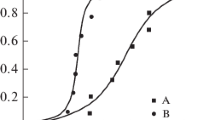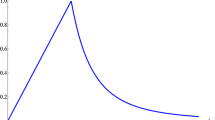Abstract
The paper presents a review of studies dedicated to the development of a local approach to brittle fracture in metals and alloys. To work out a statistical criterion of local fracture in a metal in the vicinity of a stress concentrator is shown to be the key task of the local approach. The author substantiates a possibility of describing the process of brittle (quasibrittle) fracture in metals ahead of the notch on the basis of “primary principles,” i.e., on the basis of the analysis of the processes of formation and catastrophic growth of crack nuclei. The physical effects have been established, which must be allowed for in the development of the local fracture criterion. The author considers the main factors that govern the size of the “process zone.” This parameter has been found to depend on the value of the relative gradient of the local plastic strain intensity. The appropriateness of using the Weibull distribution to describe quasibrittle fracture of metals is analyzed. It is demonstrated that the Weibull parameters are not material's constants as postulated in the conventional variant of the local approach. Their values depend on the local plastic strain and the metal stress state in the vicinity of the stress concentrator.
Similar content being viewed by others
REFERENCES
G. V. Uzhik, Cleavage Resistance and Strength of Metals [in Russian], Izd. AN SSSR, Moscow (1950).
J. F. Knott, Fundamentals of Fracture Mechanics [Russian translation], Metallurgiya, Moscow (1978).
G. S. Pisarenko and A. Ya. Krasovskii, “Ananlysis of kinetics of quasibrittle fracture of crystalline materials,” in: Mechanical Behavior of Materials, Proc. Int. Conf. ICM-1 (Kyoto, JSMS, 1972), 1, Kyoto (1971), pp. 421–432.
A. Ya. Krasovskii, Brittleness of Metals at Low Temperatures [in Russian], Naukova Dumka, Kiev (1980).
A. Ya. Krasovskii and G. Pluvinage, “Minimal resistance of engineering materials to brittle fracture as predicted by local approach,” J. de Physique IV, C6, 215–224 (1966).
R. O. Ritchie, J. F. Knott, and J. R. Rice, “On the relation between critical tensile stress and fracture toughness in mild steel,” J. Mech. Phys. Solids, 21, No. 6, 395–410 (1973).
F. M. Beremin, “A local criterion for cleavage fracture of a nuclear pressure vessel steel,” Met. Trans., 14A, 2277–2287 (1983).
M. D. Fant, V. Le Cog, O. Cleizergues, et al., “Development of a simplified approach for using the local approach to fracture,” J. de Physique IV, C6, 503–512 (1996).
C. S. Wiesner, The Local Approach to Cleavage Fracture-Concepts and Applications, Abington Publishing, Cambridge (1996).
B. Strnadel, “Critical characteristic ligament for cleavage fracture in spheroidized steels,” Theor. Appl. Fract. Mech., No. 19, 105–111 (1993).
D. A. Carry and J. F. Knott, “Relationship between fracture toughness and microstructure in the cleavage fracture of mild steel,” Met. Sci., 10, No. 1, 1–6 (1976).
K. Kune, Einflu? des Spannungszustandes und des Gefüges auf die Spaltbruchspannung von Baustählen, BRD, Aachen (1982).
Lin Tsann, A. G. Evans, and R. O. Ritchie, “Statistical analysis of cleavage fracture ahead of sharp cracks and rounded notches,” Acta Met., 34, No. 11, 2205–2216 (1986).
C. S. Wiesner and M. R. Godthorper, “The effect of temperature and specimen geometry on the parameters of the “Local Approach” to cleavage fracture,” J. de Physique IV, C6, 295–304 (1996).
V. Kozak and A. Janik, “The use of the local approach for the brittle fracture behavior of cast steel and its prediction based on the local approach,” in: I. Dlouhy (Ed.), Transferability of Fracture Mechanical Characteristics, Kluwer Academic Publishers (2001), pp. 105–122.
S. A. Kotrechko, “A statistical model of brittle fracture in polycrystalline metals,” Metallofiz. Nov. Tekhnol., 16, No. 10, 37–49 (1994).
S. A. Kotrechko, “On the influence of far-ranging microstresses on the loss of stability of crack nuclei in a polycrystal,” Metallofiz. Nov. Tekhnol., 16, No. 7, 60–64 (1994).
A. V. Gur'ev and E. P. Bogdanov, “The effect of structural stresses on strength of polycrystalline materials,” Probl. Prochn., No. 1, 68–73 (1984).
S. A. Kotrechko, “A statistical model of brittle fracture in ferrite-pearlitic steels,” Metallofiz. Nov. Tekhnol., 23, No. 1, 103–122 (2001).
S. A. Kotrechko and Yu. Ya. Meshkov, “Fundamentals of the physical theory of quasibrittle fracture in polycrystalline metals in nonuniform fields induced by stress concentrators,” Metallofiz. Nov. Tekhnol., 20, No. 4, 46–58 (1998).
S. A. Kotrechko and Yu. Ya. Meshkov, “Mechanics and physics of quasibrittle fracture of polycrystalline metals under conditions of stress concentration. Part 2. Theoretical basis,” Probl. Prochn., No. 3, 5–16 (1999).
J. Sun and J. D. Boyd, “Cleavage stress on the delamination plane of a plate steel,” in: Ninth Int. Conf. on Fracture (Sydney, 1-5 April 1997), Sydney (1997), pp. 507–515.
G. S. Pisarenko and A. A. Lebedev, Deformation and Strength of Materials at a Complex Stress State [in Russian], Naukova Dumka, Kiev (1976).
P. M. Vitvitskii and S. Yu. Popina, Strength and Criteria for Brittle Fracture of Stochastically Defected Solids [in Russian], Naukova Dumka, Kiev (1980).
S. A. Kotrechko, Yu. Ya. Meshkov, and I. Dlouhy, “Computer simulation of effect of grain size distribution on Weibull parameter,” Theor. Appl. Fract. Mech., 35, 255–260 (2001).
Author information
Authors and Affiliations
Rights and permissions
About this article
Cite this article
Kotrechko, S.A. A Local Approach to Brittle Fracture Analysis and Its Physical Interpretation. Strength of Materials 35, 334–345 (2003). https://doi.org/10.1023/A:1025882006464
Issue Date:
DOI: https://doi.org/10.1023/A:1025882006464




